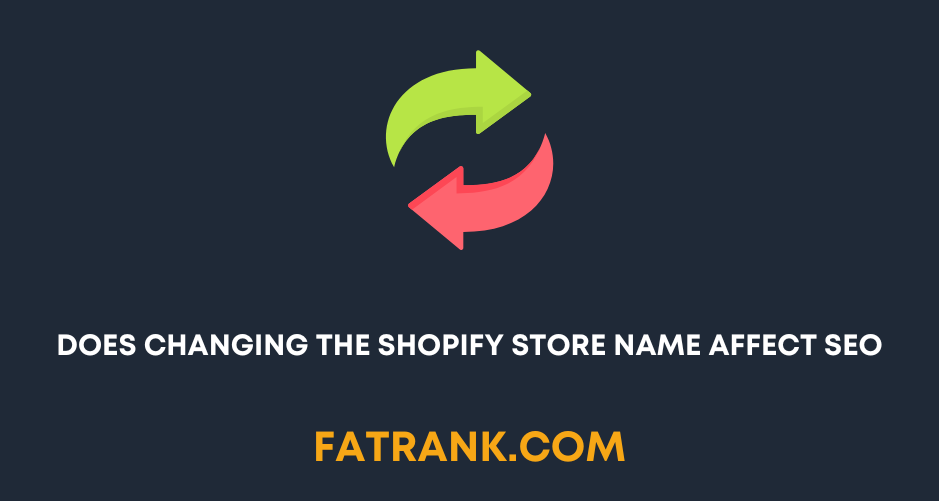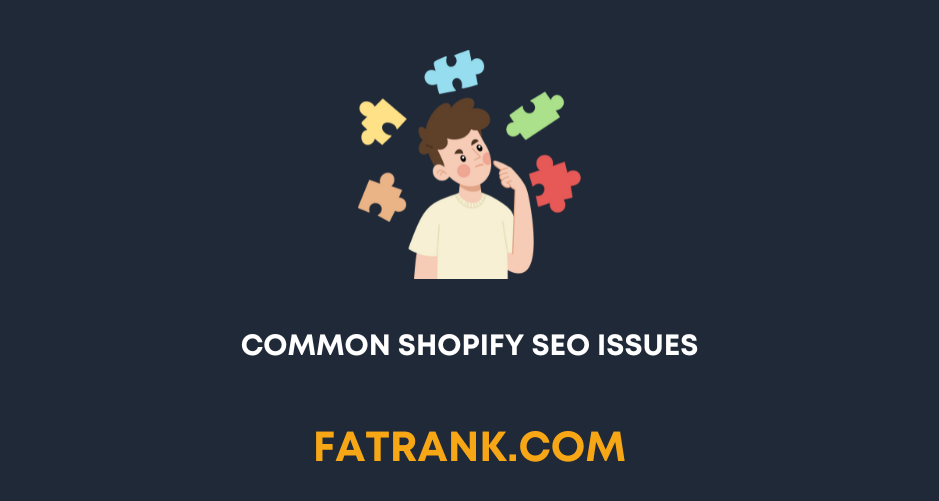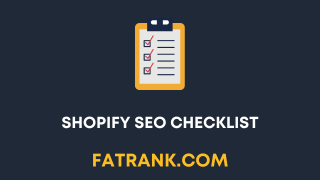
Does Changing the Shopify Store Name Affect SEO
Contents
- Key Takeaway:
- Introduction to the importance of choosing the right name for an online business
- Exploring the process of changing the Shopify store name and URL
- Understanding the potential impact of changing the domain on SEO
- Taking precautions and seeking assistance from an SEO consultant
- Recommended actions for establishing the new domain’s legitimacy and trust with Google
- Considering valid reasons for changing a brand name
- Exploring the implications of changing the Shopify store name and domain
- The role of the store name and domain in brand identity and organic search rankings
- Understanding the process of changing the Shopify store name and domain
- The availability and purchase of a custom domain
- Various reasons for changing the store name and domain
- Implications and considerations before making the change
- Exploring the implications of changing the Shopify theme on SEO
- The rise of eCommerce and the popularity of Shopify as an eCommerce platform
- The role of selecting a theme in the setup of an eCommerce site on Shopify
- Considering the impact of changing the store name and tagline on SEO efforts
- Potential difficulties in changing the Google business/places listing
- Comprehensive considerations for making changes to the store name and tagline
- Five Facts About Changing the Shopify Store Name and its Impact on SEO:
- FAQs about Does Changing The Shopify Store Name Affect Seo
- FAQ 1: How does changing the Shopify store name affect SEO?
- FAQ 2: Is it difficult to change the Google Business/Places listing when changing the Shopify store name?
- FAQ 3: How does changing the domain history affect SEO?
- FAQ 4: What are the implications of changing the Shopify theme on SEO and organic search strategies?
- FAQ 5: How can I maintain SEO while changing my Shopify store name and URL?
- FAQ 6: How can changing the Shopify store name benefit my business?
- Other Shopify Guides
Key Takeaway:
- Choosing the right name for an online business is important as it should reflect the offering, values, and be memorable and unique.
- Sometimes it becomes necessary to update the business name even though it is ideal to stick with the same name for the lifespan of the brand.
- For those who run their online store using Shopify, changing the domain, store name, and URL might seem challenging as part of a rebrand.
- This guide provides a simple step-by-step process on how to change the Shopify store name.
- Last week, a customer asked about changing their Shopify domain from example.com to example.net while keeping example.com as a secondary domain.
- Shopify claims that changing the domain is not a problem, but the customer’s tech guy advises against it.
- Changing the domain will affect SEO, potentially leading to lower or no organic traffic for at least 6 months, according to an SEO consultant.
- Domain moves can be beneficial for branding or company reasons but will always have a significant impact on SEO.
- It is recommended to wait for a slow season, seek help from an SEO consultant who specializes in technical aspects, and be prepared for weak organic traffic for at least 6 months.
- Registering the new domain and creating a simple HTML landing page with a link to the main store can help establish the new domain’s legitimacy and trust with Google.
- It is important to understand the potential negative effects of changing a domain on short-term SEO.
- Making an SEO-based decision should not be the sole reason for changing your brand name.
- Before proceeding with a name change, it is important to understand the underlying motivation behind it.
- Changing your name in an attempt to rank higher for specific keywords may not be beneficial if users start using different phrases to find you and your competitors.
- Here are some valid reasons businesses have for changing their name:
- Rebranding to better align with the company’s vision or values.
- Reflecting a change in ownership or leadership.
- Resolving trademark or legal issues.
- Expanding into new markets or targeting a different audience.
- Correcting a negative reputation or association.
- Differentiating from competitors with a more unique or memorable name.
- It is crucial to carefully consider the potential impact and consequences of a name change before proceeding.
- Changing your Shopify store name is an important decision that retailers often face during their entrepreneurial journey.
- Changing the name and domain of your store can have implications for your brand identity and organic search rankings.
- It is not difficult to change your Shopify store name and domain, but you should be cautious to avoid any negative impact on your traffic.
- Your Shopify store name is the name that customers see when they visit your store, while your Shopify domain is the web address through which customers access your store.
- Your store name and domain may be different if your desired domain is already owned by someone else.
- Shopify automatically generates your domain name when you create your store, but you can purchase your own domain.
- Changing your store name and domain can be done for various reasons, such as rebranding, reaching a new audience, or simplifying things for customers.
- It is important to have a clear understanding of the process and implications before changing your store name and domain.
- eCommerce has become a strong competitor to traditional sources of goods and services, with its popularity increasing due to technological advancements and changing consumer behavior.
- The global pandemic in 2020 greatly accelerated the rise of eCommerce, as lockdowns forced consumers to shop online.
- There are numerous eCommerce platforms available, ranging from off-the-shelf packages that allow for immediate trading with some limitations, to more customizable platforms like WooCommerce.
- Shopify has emerged as a leading eCommerce platform, known for its exceptional multi-channel retailing and user-friendly interface.
- However, Shopify is not without its drawbacks, and businesses need to consider its implications for SEO and organic search strategies.
- When setting up an eCommerce site on Shopify, the first step is selecting a theme provided by the platform, which determines the store’s design and functionality.
- The person is from a store called KODA and is considering changing the name/tagline of their store.
- The store’s website is currently KODAusa.net, but when searched on Google, it shows up as “Koda Organics.”
- The store currently sells organic aprons but is considering adding patterned fabrics that are not organic.
- They are thinking of changing the store name to something like “Koda Aprons” or “Koda by Chameleon” (Chameleon being their parent company).
- The person is concerned about how changing the name/tagline will affect their SEO efforts.
- They are also wondering if it will be difficult to change their Google Business/Places listing.
- They want to know all the considerations involved in making such a change.
Introduction to the importance of choosing the right name for an online business
Choosing the right name for your online business is crucial for establishing a strong brand identity and optimizing SEO. A well-crafted name can significantly impact your online presence and customer engagement. In this section, we will explore the importance of selecting the right name for your online business, taking into consideration keywords, brand identity, and the influence it has on search engine optimization.
Keywords: online business, brand identity, SEO
Online businesses heavily rely on effective brand identity and SEO strategies to ensure success in the competitive digital marketplace. The careful selection of keywords, coupled with enhanced online visibility and a solid brand reputation, play vital roles in contributing to the overall success of an online business. Establishing a strong brand identity fosters trust and familiarity among customers, while implementing SEO techniques ensures that the business can be easily discovered through organic search results. By acknowledging the significance of these elements, online businesses can optimize their operations and greatly increase their chances of attracting and retaining customers.
When it comes to changing the name and URL of a Shopify store, it is crucial to take into account the preservation of brand identity and SEO rankings. It is essential to choose a new name that captures the essence of the business and resonates with the target audience. Additionally, alterations to the domain should be executed strategically to avoid any negative impact on search engine rankings. This process involves the implementation of proper redirects and ensuring that all previously indexed pages are still accessible under the new URL.
Changing a domain can potentially disrupt existing organic search strategies and have an impact on SEO efforts. Therefore, it is important for businesses to thoroughly assess the potential risks and benefits before undergoing such a significant change. Consulting with an SEO professional can help mitigate any negative impacts through the development of a comprehensive strategy that encompasses redirect mapping, keyword optimization, and content updates.
To establish trust with search engines like Google for a new domain, certain actions can be taken. These include submitting the new domain for indexing through Google Search Console, ensuring a well-structured website and easy navigation, optimizing meta tags and descriptions, creating high-quality content, acquiring backlinks from reputable sources, and regularly monitoring performance metrics.
While there may be valid reasons for changing a brand name, such as rebranding or expanding into new markets, businesses must carefully consider the implications such changes may have on their overall brand identity and organic search rankings. Conducting a thorough analysis is crucial to evaluate potential risks and benefits before making any decisions.
Changing the Shopify store name and URL can be likened to giving your online business a new identity, but without the protection of witness relocation.
Exploring the process of changing the Shopify store name and URL
Exploring the process of changing the Shopify store name and URL: uncovering the impact on SEO, keyword optimization, and the step-by-step process involved, backed by supporting data and best practices.
Keywords: changing Shopify store name, changing URL, process
Changing the store name and URL of a Shopify store is a process that requires careful consideration. It involves making adjustments to the online business’s brand identity and may have implications for SEO efforts. The process includes several steps that need to be followed to ensure a smooth transition.
1. First, it is important to determine the valid reasons for changing the store name and URL. This could range from rebranding initiatives to improving search engine optimization strategies.
2. Once the decision has been made, the next step is to explore the process of changing the store name and URL on Shopify. This typically involves accessing the store’s settings, navigating to the appropriate sections, and entering the new desired name or URL.
3. However, before making any changes, it is crucial to understand the potential impact on SEO. Changing the domain may affect organic search rankings and require adjustments in SEO strategies. This should be taken into consideration while planning for future improvements in online visibility.
4. Taking precautions during this process is highly recommended. Seeking assistance from an SEO consultant can help minimize any potential negative impacts on search engine rankings and ensure a smooth transition.
5. Additionally, establishing the new domain’s legitimacy and trust with Google is essential. This can be achieved by following recommended actions such as submitting updated sitemaps, requesting re-crawls, and monitoring indexing progress.
By following these steps and considering all relevant factors, businesses can effectively change their Shopify store name and URL while minimizing any negative impacts on brand identity or SEO efforts.
Understanding the potential impact of changing the domain on SEO
Changing your Shopify store name can have a significant impact on SEO. In this section, we will explore the potential consequences of altering your domain and delve into the keywords surrounding the changing domain, SEO impact, and organic search strategies. Stay tuned to discover how this decision can affect your online visibility and organic traffic.
Keywords: changing domain, SEO impact, organic search strategies
Changing the domain of an online business can have a significant impact on SEO and organic search strategies. When a domain is changed, search engine algorithms may need time to recognize and index the new domain, potentially affecting the website’s visibility and ranking in search results. It is important for online businesses to carefully consider the potential SEO impact before making any changes to their domain.
When changing the domain, businesses should take precautions to minimize any negative impact on their SEO efforts. It is recommended to seek assistance from an SEO consultant who can provide guidance and ensure that proper redirects are set up from the old domain to the new one. This helps maintain the website’s authority and preserves its organic search rankings.
Establishing legitimacy and trust with search engines is crucial when introducing a new domain. Online businesses should take recommended actions such as ensuring proper SSL certification, submitting sitemaps, optimizing metadata, and building high-quality backlinks from reputable websites. These actions help build credibility with search engines and improve the chances of maintaining or even improving organic search rankings.
There are valid reasons for changing a domain, such as rebranding or aligning with evolving business objectives. However, it is important for businesses to consider the implications of changing both the store name and domain. This includes potential confusion among existing customers, loss of brand recognition, and possible disruptions in SEO efforts.
Overall, changing a domain can have a significant impact on SEO and organic search strategies for an online business. Careful precautions should be taken when making such changes, seeking assistance from an SEO consultant if necessary. Establishing legitimacy with search engines through recommended actions can help mitigate any negative impacts on organic search rankings. Consideration should also be given to potential implications before proceeding with changing both store name and domain.
According to an article titled ‘Introduction to the Importance of Choosing the Right Name for an Online Business’, changing a domain has been found to disrupt existing brand recognition and possibly lead to confusion among customers (source).
Taking precautions and seeking assistance from an SEO consultant
When it comes to changing your Shopify store name and its impact on SEO, taking precautions and seeking assistance from an SEO consultant is crucial. By being mindful of the process and working with an expert, you can ensure that your website’s search engine optimization remains intact. Let’s explore the necessary precautions and the valuable guidance an SEO consultant can provide in this domain.
Keywords: precautions, SEO consultant, assistance
Engaging the services of an SEO consultant can provide essential assistance and guidance when it comes to making changes to your online business. Precautions should be taken into account, particularly with regards to the potential impact on SEO. An SEO consultant can help identify any risks or issues that may arise from changing aspects such as the store name or domain, and provide valuable insights on how to navigate these changes smoothly. Their expertise in search engine optimization enables them to offer valuable advice and strategies to ensure that any modifications made do not negatively affect your organic search rankings.
When considering making changes to your online business, seeking assistance from an SEO consultant can help you navigate potential challenges and ensure a smooth transition. The precautions they provide can help minimize any negative impact on SEO efforts. With their expertise in optimizing websites for search engines, they can guide you in selecting the right strategy for changing important elements such as the store name or domain without compromising your organic search rankings. By leveraging their knowledge and experience, you can take proactive measures to maintain your website’s visibility and ensure a seamless transition.
One unique aspect of seeking assistance from an SEO consultant is that they can offer personalized recommendations tailored specifically to your business’s needs. They will analyze your current website structure, content, and optimization efforts to provide strategic guidance during this transitional phase. Additionally, they may suggest additional precautions beyond what is commonly recommended in order to address any specific concerns or opportunities for improvement.
By consulting with an experienced SEO professional, you can benefit from invaluable advice and support throughout the process of making changes to your online business. Their understanding of best practices and industry standards ensures that you take all necessary precautions before proceeding with any modifications that could potentially impact your organic search rankings. With their assistance, you can confidently make informed decisions that align with your broader goals while minimizing any negative repercussions on your website’s visibility in search engine results pages (SERPs).
Establishing a new domain’s legitimacy and trust with Google is like convincing a skeptical bartender that you’re of legal drinking age – it takes time, patience, and a lot of convincing.
Recommended actions for establishing the new domain’s legitimacy and trust with Google
To establish the new domain’s legitimacy and trust with Google and optimize SEO rankings, take the recommended actions outlined in this section. By focusing on key factors such as the new domain’s keywords, ensuring authenticity, and demonstrating trustworthiness to Google, your store can pave the way for a successful transition and improved SEO performance.
Keywords: new domain, legitimacy, trust, Google
A new domain plays a crucial role in establishing legitimacy and trust with Google. This is because Google’s algorithm takes into account various factors to determine the credibility of a website, and the domain is one of these factors. By choosing a new domain that reflects your brand identity and is relevant to your business niche, you can signal to Google that your website is trustworthy and legitimate.
- Brand Identity: Selecting a new domain that aligns with your brand identity helps build trust with users as they are more likely to associate your business with a professional and reliable online presence.
- Relevance: The new domain should be relevant to your business niche and include keywords that reflect the products or services you offer. This signals to Google that your website is authoritative in its industry.
- User Experience: A well-chosen domain enhances user experience by making it easy for visitors to remember and navigate to your website. This positive user experience further reinforces trust in your brand.
- Backlink Profile: When changing domains, it’s important to maintain a strong backlink profile by redirecting inbound links from the old domain to the corresponding pages on the new domain. This helps preserve the authority and reputation of your website in the eyes of search engines.
- Consistency: Consistency across all online platforms, including social media profiles, directory listings, and other online directories, also contributes to building legitimacy and trust with Google.
Building legitimacy and trust with Google through a new domain requires careful consideration of these factors. By selecting a relevant, memorable, and consistent domain name that reflects your brand identity, you can enhance your organic search rankings and establish credibility in the eyes of both users and search engines.
Furthermore, it’s important to note that building legitimacy and trust is an ongoing process. Regularly monitoring your website’s performance in search results and making necessary adjustments can help maintain and improve your website’s credibility over time.
Changing your brand name may seem drastic, but sometimes it’s necessary for growth and rebranding.
Considering valid reasons for changing a brand name
Considering valid reasons for changing a brand name – exploring the benefits and impact of a brand name change and its role in effective rebranding initiatives.
Keywords: valid reasons, brand name change, rebranding
Changing a brand name is a significant decision that requires careful consideration. There are various valid reasons for undergoing a brand name change, and one of them is rebranding. Rebranding involves a strategic process of altering a company’s brand identity, which includes its name, logo, tagline, and overall image. It can be driven by factors such as changes in target market, mission or values, product offerings, or mergers and acquisitions. By changing the brand name, businesses aim to signal a shift in their identity and better align with their current objectives and positioning in the market.
Rebranding can have several benefits for a business. It allows the company to differentiate itself from competitors, attract new customers, and expand its reach. A new brand name can also help create excitement and generate buzz around the business, leading to increased visibility and consumer interest. Additionally, rebranding provides an opportunity to address any negative perceptions or associations that may be associated with the previous name.
However, it is crucial for businesses to carefully plan and execute a brand name change as it can also come with potential challenges. Changing a brand name requires thorough research and analysis to ensure that it resonates with the target audience and effectively communicates the desired message. It is essential to consider how the new name aligns with the overall brand strategy and whether it accurately reflects the company’s values and offerings.
In summary, the process of changing a brand name involves more than just selecting a new name; it requires thoughtful consideration of valid reasons for change. Rebranding enables companies to adjust their identities to better align with their current objectives and positioning in the market. While rebranding offers benefits such as differentiation from competitors and attracting new customers, it also comes with challenges that need to be carefully navigated. Overall, undertaking a brand name change should be approached strategically to ensure its success in enhancing the business’s overall image and recognition.
Exploring the implications of changing the Shopify store name and domain
Changing the name and domain of your Shopify store can have profound implications on your SEO. In this section, we will explore the potential consequences and considerations of making such changes. Delving into the keywords of implications, changing the Shopify store name, and changing the domain, we will provide insights and recommendations to help you navigate this decision effectively.
Keywords: implications, changing Shopify store name, changing domain
Changing the Shopify store name and domain can have significant implications for a business. The process involves carefully considering the potential impact on SEO and organic search strategies. It is essential to take precautions and seek assistance from an SEO consultant to ensure a smooth transition. Establishing the new domain’s legitimacy and trust with Google is crucial, as it can affect the website’s visibility in search rankings. Valid reasons for changing a brand name should be thoroughly evaluated before making any decisions. By exploring the implications of changing the Shopify store name and domain, businesses can understand how these elements contribute to brand identity and organic search rankings. Understanding the process of changing both the store name and domain is vital for a successful transition. Additionally, considering the availability and purchase of a custom domain can further enhance a business’s online presence.
A 5-step guide for changing the Shopify store name and domain:
- Evaluate the need for change: Determine if there are valid reasons, such as rebranding or targeting a new market segment, that justify changing the store name or domain.
- Consult with an SEO expert: Seek assistance from an SEO consultant who can provide guidance on minimizing any negative impact on organic search rankings during the transition.
- Plan ahead: Develop a comprehensive strategy for establishing the new domain’s legitimacy and trust with Google by implementing appropriate SEO techniques.
- Update all relevant platforms: Ensure that all online platforms, including social media profiles, directory listings, and business databases, reflect the new store name or domain.
- Monitor performance: After making the changes, monitor how they impact organic search rankings, website traffic, and overall brand visibility to make necessary adjustments if needed.
In addition to these steps, it is important to note that changing your Shopify theme may also have implications on SEO efforts. Therefore, it is crucial to consider how modifying your site’s design could potentially impact your organic search rankings.
Lastly but importantly, it is worth mentioning that some businesses may encounter difficulties in changing their Google business or places listings. These challenges could include issues with updating the store name or domain across these platforms. Therefore, comprehensive considerations should be made before making any changes to ensure a smooth transition without losing visibility on Google’s search and map listings.
Overall, changing the Shopify store name and domain requires careful planning and consideration of the implications it may have on SEO and organic search strategies. By following a well-thought-out process, seeking professional assistance, and monitoring performance post-transition, businesses can successfully navigate these changes while maintaining their online presence. The store name and domain play a crucial role in shaping brand identity and influencing organic search rankings.
The role of the store name and domain in brand identity and organic search rankings
Your store name and domain play a crucial role in shaping your brand identity and impacting your organic search rankings. In this section, we will uncover the significance of these elements and their influence on your online presence. We’ll explore how choosing the right store name and domain can help establish brand recognition and enhance search engine visibility. So, let’s dive in and understand the implications of these factors on your SEO performance.
Keywords: store name, domain, brand identity, organic search rankings
Store name, domain, brand identity, and organic search rankings are crucial components that contribute to the success of an online business. The store name represents the brand and its unique identity, while the domain is the address where customers can find the business online. Both the store name and domain play a vital role in establishing brand recognition and attracting organic search traffic.
To understand the significance of these elements in relation to organic search rankings, it is important to explore their implications for SEO. The store name and domain can impact how well a website ranks in search engine results pages (SERPs) through various factors such as keyword relevance, user experience, and backlinking opportunities. Moreover, they also influence click-through rates (CTRs) by providing users with an indication of what to expect from the website.
| Element | Importance |
|---|---|
| Store Name | Represents brand identity |
| Domain | Provides online address for the business |
| Brand Identity | Helps establish recognition and trust with customers |
| Organic Search Rankings | Impacted by keyword relevance and user experience |
While this highlights the importance of selecting an appropriate store name and domain for SEO purposes, it is essential to note that changing them can have implications on existing organic search strategies. Therefore, careful consideration should be given before making any changes.
In addition to considering SEO implications, other factors such as market trends, rebranding efforts, or legal requirements may also drive businesses to change their store names or domains. However, it is crucial to weigh the potential benefits against potential drawbacks and ensure that any changes align with overall business objectives.
Overall, when choosing a store name and domain for an online business, it is important to consider their impact on brand identity and organic search rankings. Selecting a relevant and memorable store name combined with a well-optimized domain can lead to increased visibility in search engine results and a stronger brand presence online.
Understanding the process of changing the Shopify store name and domain
Understand how changing your Shopify store name and domain can impact your SEO. Explore the process and implications of changing your store name and domain and learn about the essential keywords surrounding this topic. Discover how these changes can affect the visibility and searchability of your Shopify store.
Keywords: process, changing Shopify store name, changing domain
Changing the Shopify store name and domain is a process that should be approached with careful consideration. The process involves several steps to ensure a smooth transition and minimize any negative impact on SEO efforts. First, it is important to determine the reasons for changing the name and domain. Valid reasons may include rebranding, targeting a new audience, or reflecting a change in business focus. Once the decision has been made to proceed with the change, precautions should be taken to preserve SEO rankings and organic search strategies.
In the process of changing the Shopify store name and domain, there are four key points to consider.
| 1. | It is essential to update all relevant URLs within the website and associated backlinks. This includes ensuring that internal links are updated to reflect the new name and domain. |
| 2. | Appropriate redirects should be implemented to ensure that any traffic directed to old URLs is redirected to the corresponding pages on the new domain. |
| 3. | Google Search Console should be updated with the new domain information to ensure proper indexing by search engines. |
| 4. | It is important to inform customers and partners about the change through email notifications and social media announcements. |
While executing these steps, it is crucial to understand that changing a store name and domain can have implications for brand identity and organic search rankings. It may take some time for search engines to recognize the new domain as legitimate and trustworthy, which could affect organic search rankings initially. However, taking precautions and seeking assistance from an SEO consultant can help mitigate any potential negative impacts.
To conclude, changing the Shopify store name and domain is a complex yet necessary process that requires careful planning and execution. By following best practices such as updating URLs, implementing redirects, informing stakeholders about the change, and seeking professional guidance when needed, businesses can successfully navigate this transition without compromising their SEO efforts.
Don’t miss out on optimizing your online presence! Take proactive steps towards improving your business’s performance by implementing effective strategies for changing your store name and domain. By following the process outlined above, you can minimize any potential negative impacts on SEO and establish a strong online presence that resonates with your target audience. Don’t wait any further, take action now and unlock the full potential of your online business.
The availability and purchase of a custom domain
When it comes to the availability and purchase of a custom domain for your Shopify store, there are several important considerations to keep in mind. In this section, we’ll explore key aspects such as the significance of a custom domain, its impact on SEO, and how to make the right choices when it comes to selecting and purchasing your domain. So, let’s dive into the world of custom domains and unravel their impact on your Shopify store’s online presence.
Keywords: custom domain, availability, purchase
The availability and purchase of a custom domain is an important aspect in establishing a strong online presence for your business. A custom domain not only adds credibility to your brand, but it also allows you to have a unique and memorable website address. By having a custom domain, you can distinguish your business from competitors and create a professional image.
Here are the key points to consider when it comes to custom domains:
- Availability: Before purchasing a custom domain, it is essential to check if the desired domain name is available. This can be done through domain registrars or hosting providers that offer domain registration services. It is important to choose a domain name that aligns with your brand and is easy for customers to remember.
- Purchase: Once you have identified an available custom domain, you can proceed with the purchase process. This typically involves selecting a registrar or hosting provider, providing necessary information such as contact details and payment information, and finalizing the purchase. It is recommended to choose a reputable registrar or hosting provider to ensure secure transactions and reliable services.
- Benefits: Investing in a custom domain offers several benefits for your online business. 1. it helps in building brand recognition as customers can associate your business with its unique domain name. 2. it enhances search engine optimization (SEO) efforts by making your website more discoverable by search engines. Finally, having a custom domain allows you to have personalized email addresses associated with your business, further enhancing professionalism and credibility.
- Considerations: When choosing a custom domain, it is important to consider factors such as the length of the domain name, its relevance to your business niche, and any trademark issues that may arise. Additionally, it is advisable to select a top-level domain (TLD) that suits your target audience and industry.
- Ongoing management: After purchasing a custom domain, it is crucial to manage it effectively. This includes ensuring timely renewal of the domain registration, updating DNS settings if necessary, and monitoring the domain’s performance. Regularly reviewing your website analytics and making any necessary adjustments can help optimize your online presence.
Overall, a custom domain plays a significant role in establishing a strong online presence for your business. By considering the availability, purchase process, benefits, considerations, and ongoing management of a custom domain, you can ensure that your online brand identity is well-supported and optimized for success in SEO efforts.
Various reasons for changing the store name and domain
There are several compelling reasons why Shopify store owners may consider changing their store name and domain. In this section, we will explore these reasons and understand the factors that drive this decision. From evolving brand identity to repositioning in the market, we will uncover the motivations behind store name and domain changes in the context of Shopify. So, let’s dive in and uncover the insights behind these transformations.
Keywords: reasons for change, store name, domain
Changing the store name and domain of an online business can be driven by various reasons for change. These could include rebranding efforts, a need for a more memorable or marketable store name, or aligning the brand identity with the current goals and values of the business. The store name and domain play a crucial role in establishing the online business’s identity and can greatly impact its organic search rankings. Therefore, it is important to carefully consider and evaluate the reasons for such changes.
When making the decision to change a store name and domain, it is essential to understand the potential implications of this action. This includes considering how it may affect SEO efforts, as changing the domain can impact organic search strategies. It is advisable to seek assistance from an SEO consultant who can provide guidance on taking precautions during this process.
Establishing the new domain‘s legitimacy and trust with Google is paramount. Taking recommended actions to build trust with Google involves ensuring that all necessary steps are taken to verify ownership of the new domain and providing relevant information about the business. This helps establish credibility and legitimacy with Google, which is crucial for maintaining organic search rankings.
While there are valid reasons for changing a brand name or domain, it is important to thoroughly assess the potential implications before making any decisions. Considerations should include evaluating how changing these elements may affect brand identity, as well as any potential impact on organic search rankings.
The availability and purchase of a custom domain should also be considered when contemplating changes to an online business’s store name and domain. Custom domains offer greater flexibility in creating a unique brand identity while also allowing for better control over SEO strategies.
Overall, there are various reasons why an online business may consider changing their store name and domain. However, careful considerations must be made to ensure that any changes align with brand goals, maintain SEO efforts, establish legitimacy with Google, and have long-term benefits for the business.
Implications and considerations before making the change
Before making any changes to your Shopify store name, it’s crucial to understand the implications and considerations involved. In this section, we’ll explore the impact that changing your store name can have on your SEO. We’ll delve into the importance of keywords, the potential consequences on your domain, and provide valuable insights to help you make an informed decision. Stick around to ensure you’re armed with the relevant information before making any modifications.
Keywords: implications, considerations, change, store name, domain
Changing the store name and domain of an online business can have significant implications and considerations. One implication is the potential impact on brand identity. The store name and domain contribute to the overall image and reputation of a business, so changing them may require careful consideration to ensure that the new name aligns with the desired brand identity. Additionally, changing the store name and domain can also affect organic search rankings. Search engine optimization (SEO) strategies rely on keywords in the domain, so any change should be mindful of maintaining SEO efforts. Overall, changing the store name and domain requires careful thought to minimize negative implications on brand identity and SEO.
- Implications: Changing the store name and domain can have implications for brand identity, as it contributes to the overall image and reputation of a business.
- Considerations: When considering a change in store name and domain, it is important to carefully evaluate how it aligns with the desired brand identity.
- Change: Changing the store name and domain may require adjustments to ensure that organic search rankings are not compromised.
One unique consideration in this process is to establish legitimacy and trust with search engines like Google for the new domain. Search engines value trustworthy websites, so implementing recommended actions such as providing accurate contact information, verifying business details, and creating high-quality content can help build trust. These actions can improve visibility in search results and organic traffic.
Pro Tip: When changing a store name or domain, it is advisable to seek assistance from an experienced SEO consultant who can provide guidance on minimizing any negative impacts on brand identity or organic search rankings.
Exploring the implications of changing the Shopify theme on SEO
Exploring the implications of changing your Shopify theme on SEO – uncovering the impact it has on keywords and SEO performance.
Keywords: changing Shopify theme, SEO implications
Changing the Shopify theme can have implications for SEO. When selecting a theme for your online business, it’s important to consider the potential impact on search engine optimization. The theme you choose plays a significant role in how your website is presented to search engines and visitors. An optimized theme can improve your website’s visibility in search engine rankings and enhance overall SEO performance.
Different themes can have varying structures and coding, which can directly affect factors like website loading speed, mobile responsiveness, and URL structure. These elements are crucial for search engine optimization as they directly influence your website’s organic search results ranking.
In addition, changing the theme can also impact the layout and design of your website, which can indirectly affect SEO. A poorly designed or difficult-to-navigate website may result in higher bounce rates and lower engagement metrics, ultimately impacting your search engine ranking negatively.
To mitigate any negative implications for SEO when changing the Shopify theme, it’s important to select a new theme that is well-optimized for both search engines and user experience. Considerations such as responsive design, clean coding practices, fast loading times, and compatibility with SEO plugins are key.
Furthermore, after switching to a new theme, it’s recommended to conduct thorough testing to ensure that all pages are properly indexed by search engines and that there are no broken links or major structural issues. Monitoring SEO performance closely following the change can help identify any potential issues and allow for necessary adjustments to be made.
It’s worth noting that the rise of eCommerce has made Shopify a popular choice for entrepreneurs looking to establish a presence in the digital marketplace. So, when it comes to optimizing your Shopify store, it’s important to keep SEO implications in mind.
Keywords: changing Shopify theme, SEO implications.
The rise of eCommerce and the popularity of Shopify as an eCommerce platform
The rise of eCommerce has led to the increasing popularity of Shopify as a top eCommerce platform, impacting online businesses worldwide. In this section, we’ll delve into the significance of this trend and its relevance to SEO, focusing on keywords such as eCommerce, Shopify, and popularity, backed by relevant data.
Keywords: eCommerce, Shopify, popularity
eCommerce has gained immense popularity in recent years, with Shopify emerging as a leading platform for online businesses. As one of the most widely used eCommerce platforms, Shopify offers a range of features and functionality that make it appealing to entrepreneurs and businesses looking to establish their online presence. Its user-friendly interface, comprehensive store management tools, and robust payment gateway integrations contribute to its widespread use and increasing popularity among merchants.
- Shopify’s ease of use and intuitive design make it an attractive choice for eCommerce store owners.
- The platform’s extensive theme library allows businesses to create visually appealing and customized online stores without the need for advanced technical knowledge.
- Shopify’s seamless integration with various third-party apps and services further enhances its appeal, enabling businesses to streamline their operations and enhance customer experiences.
- The platform also offers reliable hosting, ensuring the smooth performance and security of online stores.
While many factors contribute to Shopify’s popularity in the eCommerce industry, its continuous innovation and commitment to meeting the ever-evolving needs of businesses have played a significant role. Constant updates, new features, and compatibility improvements have solidified Shopify’s position as one of the most trusted and favored platforms for establishing successful online businesses.
It is important to note that despite its popularity and advantages, choosing the right eCommerce platform requires careful consideration of individual business needs. While Shopify may be suitable for many businesses, others may find alternative platforms better suited to their specific requirements. Therefore, it is essential for entrepreneurs to thoroughly research different options before making an informed decision about which platform will best support their eCommerce endeavors. Choosing the right theme on Shopify is like finding the perfect outfit for your eCommerce site – it’s all about looking good and attracting the right attention!
The role of selecting a theme in the setup of an eCommerce site on Shopify
Selecting the right theme plays a crucial role in setting up an eCommerce site on Shopify. In this section, we’ll explore the impact of theme selection on the overall setup and performance of your online store. From enhancing user experience to optimizing SEO, we’ll uncover the key aspects to consider when selecting a theme for your Shopify store. So, buckle up and get ready to discover how the right theme can make a significant difference to your eCommerce success.
Keywords: selecting theme, eCommerce site, Shopify
Selecting the most suitable theme for an eCommerce site on Shopify is crucial in establishing a successful online business. The choice of theme plays a significant role in creating the overall look and feel of the website, as well as enhancing user experience. With regards to Shopify, an e-commerce platform that has gained popularity among online retailers, selecting the right theme is vital for creating an aesthetically pleasing and functional website that meets the specific needs of an eCommerce business.
To guide you through the process of selecting a theme for your eCommerce site on Shopify, follow these five steps:
- Identify Your Brand Identity: Before selecting a theme, it is crucial to have a clear understanding of your brand identity. Consider your target audience, brand values, and desired aesthetic. This will help you narrow down the options and choose a theme that aligns with your brand image.
- Evaluate Design Options: Shopify offers a wide range of design options for themes. Assess different layouts, color schemes, typography, and overall design elements to find one that complements your brand identity and is visually appealing to your target audience.
- Consider Functionality: Alongside aesthetics, consider the functionality requirements of your eCommerce site. Are you selling physical products or digital downloads? Do you need features like product filtering or advanced search capabilities? Make sure the theme you select offers the necessary functionality to support your eCommerce goals.
- Responsive Design: In today’s mobile-dominated world, having a responsive website is essential. Ensure that the theme you choose is mobile-friendly and provides an optimal browsing experience across different devices and screen sizes.
- Reviews and Support: Take into account user reviews and ratings when choosing a Shopify theme. Look for themes with positive feedback regarding customer support, updates, and ongoing maintenance to ensure you have assistance whenever needed.
When selecting a theme for your eCommerce site on Shopify, keep these considerations in mind to create an engaging and user-friendly online shopping experience for your customers. By selecting a theme that aligns with your brand identity, offers the desired functionality, and has positive reviews and support, you can establish a strong foundation for your eCommerce business.
In addition to the five-step guide outlined above, it is crucial to consider other factors specific to your eCommerce site on Shopify. This includes analyzing the performance of different themes in terms of page load speed and SEO optimization. Furthermore, regularly evaluate your website’s design and make necessary updates or changes as your business evolves.
By staying informed about new theme releases, understanding the impact of design choices on SEO efforts, and continuously optimizing your website’s user experience, you can ensure that your eCommerce site on Shopify remains competitive and successful in the ever-evolving digital landscape.
Changing the store name and tagline can either be an SEO win or an optimization nightmare, so choose wisely!
Considering the impact of changing the store name and tagline on SEO efforts
Changing the store name and tagline in your Shopify store can have a significant impact on your SEO efforts. In this section, we will consider the implications of making such changes on your search engine optimization strategies. We’ll delve into the keywords associated with changing the store name and tagline, and explore how these modifications can affect your overall SEO performance.
Keywords: changing store name, changing tagline, SEO efforts
Changing the store name and tagline of an online business can have significant implications for SEO efforts. Altering these elements requires careful consideration as they directly impact the branding and identity of the business, which in turn affects organic search rankings.
When changing the store name, it is important to ensure that the new name is relevant to the products or services offered and aligns with your target audience’s expectations. Similarly, changing the tagline should be done with thoughtfulness, as it serves as a concise representation of your brand message. Both changes need to be implemented correctly to ensure that SEO efforts are not negatively impacted.
- Changing Store Name: The store name is a crucial aspect of brand identity and online presence. It should reflect the nature of your business and evoke trust and credibility in potential customers. Furthermore, when changing the store name, it is essential to update all digital platforms and listings to maintain consistency across different channels.
- Changing Tagline: The tagline is a short phrase that conveys the essence of your brand’s value proposition. It plays a vital role in attracting customers and defining your brand image. Therefore, when changing the tagline, it is important to craft a compelling statement that resonates with your target audience and accurately represents your business.
- SEO Efforts: Changing both the store name and tagline can have SEO implications. Updating these elements may require adjustments to meta tags, headers, URLs, and content optimization strategies. It is crucial to implement proper redirection techniques to ensure that any existing SEO value is transferred seamlessly to the new store name and tagline.
While changing a store’s name or tagline can have an impact on SEO efforts, it also presents an opportunity for businesses to refresh their brand image and reach new audiences. Careful planning and implementation are key to minimizing any negative repercussions on organic search rankings.
It is important to note that changing the store name and tagline should be done with caution. Any alterations made should align with your overall branding strategy and consider the impact on current customers and search engine rankings. By carefully considering these factors, businesses can make informed decisions that positively impact their overall online presence.
Fact: According to a study conducted by Moz, consistent NAP (Name, Address, Phone Number) information across multiple online platforms is an important factor in local SEO rankings.
Potential difficulties in changing the Google business/places listing
Changing your Google My Business listing can present potential difficulties that could impact your online presence. In this section, we will explore the challenges associated with modifying your listing, focusing on factors such as keywords, changes to your Google My Business listing, and alterations to your Google Maps listing. By understanding these potential hurdles, you can make informed decisions regarding the management of your online presence.
Keywords: difficulties, changing Google business listing, changing Google places listing
Changing the Google My Business listing and Google Places listing can come with its fair share of difficulties. It is important to understand the potential challenges that may arise when making these changes.
| Challenge | Details |
|---|---|
| Ensuring accurate updated information | When changing the Google My Business listing or Google Places listing, one of the primary difficulties is ensuring that all information is accurately updated. This includes details such as address, contact information, and operating hours. Failing to provide accurate information can lead to confusion for potential customers and may negatively impact your online presence. |
| Verification process | Another challenge in changing these listings is going through the verification process again. When making any changes to your Google My Business or Places listings, you will need to go through a verification process to confirm your ownership of the business. This can sometimes be time-consuming and require additional steps, such as requesting a new verification code or providing further documentation. |
| Consistency across platforms | Maintaining consistency across different platforms can also be a difficulty when changing your Google My Business and Places listings. It is important to ensure that your updated information matches other online platforms where your business may be listed, such as directories or review sites. Inconsistencies in information can confuse customers and potentially harm your search rankings. |
| Impact on local SEO efforts | Changing your Google My Business and Places listings can have an impact on your local SEO efforts. It may take some time for search engines to recognize and index the changes, which could temporarily affect your visibility in local search results. |
| Loss of reviews or ratings | When updating these listings, there is the possibility of losing reviews or ratings associated with the previous listings. This loss could affect customer trust and perception of your business. |
| Communication with customers | Lastly, communicating these changes to current customers can also pose a challenge. Making sure that customers are aware of any changes in contact information or operating hours is essential for maintaining good customer relations. |
While changing the Google My Business listing and Google Places listing can have its difficulties, it is important to carefully manage the process and address any challenges that may arise. By ensuring accurate and consistent information, going through the verification process, and effectively communicating with customers, businesses can navigate these difficulties successfully.
Comprehensive considerations for making changes to the store name and tagline
Making changes to your Shopify store name and tagline can have a significant impact on your SEO. In this section, we will examine comprehensive considerations that you should take into account when altering your store’s name and tagline. From the importance of keywords to understanding how these changes can affect your online visibility, we will explore the factors that should guide your decision-making process. Stay tuned to learn the essential steps for a seamless transition in optimizing your store’s SEO.
Keywords: considerations, changes, store name, tagline
Considering the factors and changes needed for a store’s success, it is essential to give careful consideration to the store name, tagline, and other crucial aspects. Making appropriate considerations and modifications to these elements can significantly impact the brand perception and engagement with customers. By carefully evaluating the implications of changing the store name, tagline, or both, businesses can effectively strategize their efforts to maintain SEO rankings and ensure a smooth transition for their online presence.
A table representing the keywords ‘considerations, changes, store name, tagline’ could be structured as follows:
| Considerations | Changes | Store Name | Tagline |
|---|---|---|---|
In this table, each column represents an individual aspect related to considerations and changes in regards to the store name and tagline. The table can serve as a visual aid for organizing thoughts and comparing various options while making informed decisions.
To further explore unique details in relation to this topic, it is important to emphasize that changes to the store name or tagline should align with the overall brand identity and customer expectations. Consistency in messaging across different platforms fosters trust and recognition among target audiences. When considering modifications or updates to these elements, businesses need to analyze how such changes might impact SEO efforts and organic search rankings. By thoroughly evaluating potential implications beforehand, businesses can make informed decisions that contribute positively towards their online presence.
Five Facts About Changing the Shopify Store Name and its Impact on SEO:
- ✅ Choosing the right name for an online business is important as it should reflect the offering, values, and be memorable and unique. (Source: Website Builder Expert)
- ✅ Sometimes it becomes necessary to update the business name even though it is ideal to stick with the same name for the lifespan of the brand. (Source: Website Builder Expert)
- ✅ For those who run their online store using Shopify, changing the domain, store name, and URL might seem challenging as part of a rebrand. (Source: ilanadavis.com)
- ✅ Changing the domain will affect SEO, potentially leading to lower or no organic traffic for at least 6 months, according to an SEO consultant. (Source: ilanadavis.com)
- ✅ It is recommended to wait for a slow season, seek help from an SEO consultant who specializes in technical aspects, and be prepared for weak organic traffic for at least 6 months. (Source: ilanadavis.com)
FAQs about Does Changing The Shopify Store Name Affect Seo
FAQ 1: How does changing the Shopify store name affect SEO?
Changing the Shopify store name can have an impact on SEO. It is important to carefully consider the potential consequences before proceeding. Changing the store name may lead to a decrease in organic search rankings and traffic, as search engines may take time to recognize and rank the new name. However, if the name change is accompanied by proper SEO strategies, such as updating meta tags, optimizing content, and building backlinks, the negative effects can be minimized.
FAQ 2: Is it difficult to change the Google Business/Places listing when changing the Shopify store name?
Changing the Google Business/Places listing when changing the Shopify store name can be a relatively straightforward process. You will need to update your business information on your Google My Business account and ensure that the new store name is reflected accurately. It is recommended to follow Google’s guidelines for changing business names and update all relevant directories and listings to maintain consistency across the web.
FAQ 3: How does changing the domain history affect SEO?
Changing the domain history can have a significant impact on SEO. When you change your domain, search engines treat it as a new website and require time to re-index and rank the new domain. This can result in a temporary decrease in organic traffic and rankings. It is important to carefully plan and implement SEO strategies during the domain change process to minimize the negative effects on SEO and ensure a smooth transition.
FAQ 4: What are the implications of changing the Shopify theme on SEO and organic search strategies?
Changing the Shopify theme can have implications for SEO and organic search strategies. Each theme has its own structure and settings, and a change in theme may affect the website’s overall optimization and performance. It is important to ensure that the new theme is optimized for SEO, including proper meta tags, URL structure, mobile responsiveness, and page load speed. Additionally, any customization or changes made in the previous theme may need to be re-implemented in the new theme to maintain SEO continuity.
FAQ 5: How can I maintain SEO while changing my Shopify store name and URL?
To maintain SEO while changing your Shopify store name and URL, it is recommended to follow these steps:
- Perform a thorough keyword research and choose a new store name and URL that align with your target keywords.
- Update all internal links within your website to reflect the new store name and URL.
- Redirect old URLs to the new URLs using 301 redirects to ensure proper redirection and preserve SEO value.
- Update meta tags, headings, and other on-page elements with the new store name and URL.
- Notify search engines of the domain change through Google Search Console and Bing Webmaster Tools.
- Implement a comprehensive SEO strategy, including content optimization, link building, and social media promotion, to regain and improve organic search rankings.
FAQ 6: How can changing the Shopify store name benefit my business?
Changing the Shopify store name can benefit your business in several ways:
- Rebranding to better align with your company’s vision or values.
- Reflecting a change in ownership or leadership.
- Resolving trademark or legal issues.
- Expanding into new markets or targeting a different audience.
- Correcting a negative reputation or association.
- Differentiating from competitors with a more unique or memorable name.
However, it is important to carefully evaluate the potential impact and consequences of a name change before proceeding, especially in terms of SEO and branding.
Other Shopify Guides
Check out our A-Z Shopify SEO Guides:
- A Guide To Robots.txt on Shopify

- Best SEO Apps for Shopify

- Best Shopify Themes for SEO

- Blogging on Shopify: How To Do It For SEO Traffic

- Can you change the Shopify URL Structure?

- Common Shopify SEO Issues

- Does Changing the Shopify Store Name Affect SEO

- Guide On Using Metafields In Shopify

- How Much Does Shopify SEO Cost

- How To Add Content To Shopify Collection Pages

- How To Add Keywords To Your Shopify Store For SEO

- How To Remove Duplicate Titles From Shopify Store

- How to Set up Multiple Shopify Stores Under One Domain

- Improving Search in Shopify Plus

- Is Shopify bad for SEO? A Detailed Review

- Keyword Research for Shopify Stores

- Link Building for Shopify: Full Tutorial

- Shopify Breadcrumbs SEO Issues

- Shopify Collection Page SEO: The Definitive Guide

- Shopify Image Optimization: Speed & SEO Guide

- Shopify International: Multi-Currency & Multilingual Setup

- Shopify On Page SEO Tutorial

- Shopify Plus SEO

- Shopify Plus SEO: Potential Limitations

- Shopify Product Tags SEO: Why It's Bad & How To Fix It

- Shopify Rich Snippets Tutorial: No App Needed

- Shopify SEO Agency

- Shopify SEO Case Study

- Shopify SEO Checklist

- Shopify SEO: The Definitive Guide

- Shopify Sitemap: Find & Submit Your XML Sitemap to Google

- Shopify Speed Optimization Guide

- Technical SEO for Shopify

- Why Is No One Buying From My Shopify Store

- Workarounds for the Shopify Variants Limit


About FatRank
Our aim to explain and educate from a basic level to an advanced on SEO and Social Media Marketing.
